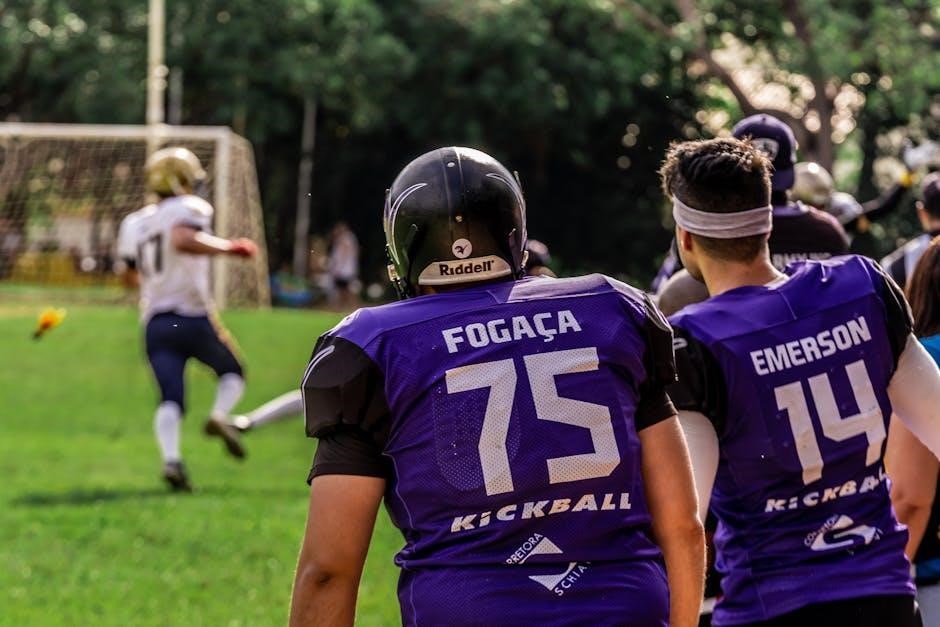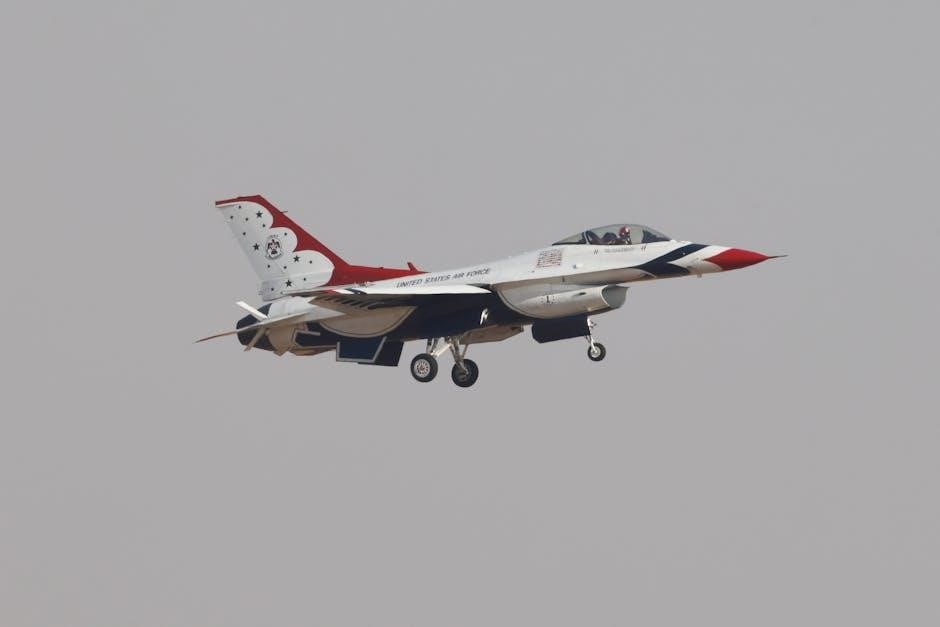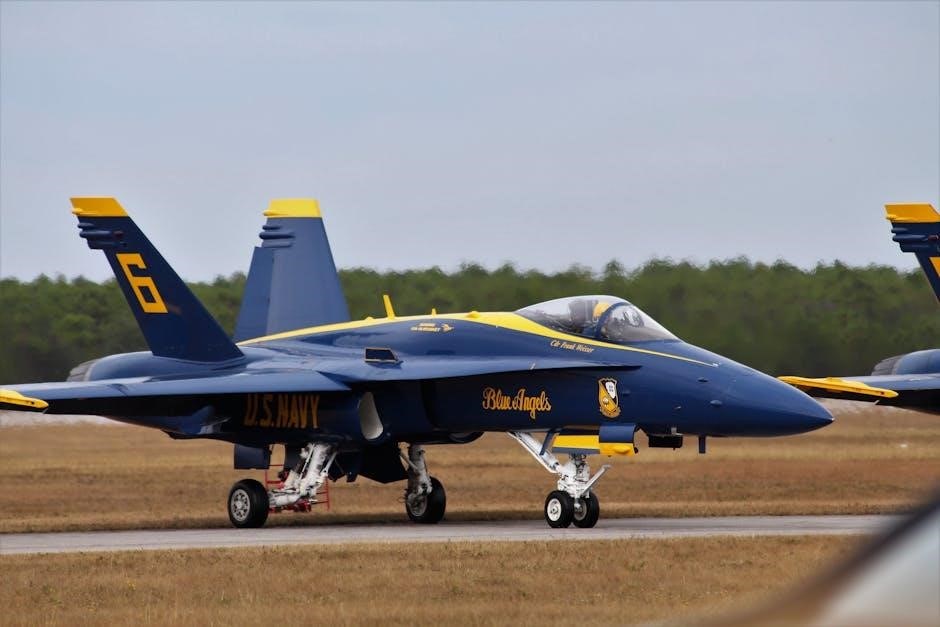6-2 Defense Playbook PDF: An Overview
The 6-2 defense playbook presents a strategic approach, often favored in youth football, emphasizing run-stopping capabilities with eight players near the line. This overview explores its effectiveness, especially against run-heavy offenses.

Understanding the 6-2 Defense
The 6-2 defense features six defensive linemen and two linebackers, prioritizing strength and physicality at the line of scrimmage. This formation aims to disrupt running plays and control the line effectively.
Definition and Basic Formation
The 6-2 defense is a football formation characterized by six defensive linemen and two linebackers. It is primarily designed to be a run-stopping formation, placing a strong emphasis on controlling the line of scrimmage. This setup typically involves three defensive linemen lined up on each side of the center, often with a nose tackle directly over the center.
The two linebackers position themselves behind the defensive line, ready to fill gaps and pursue ball carriers. The remaining three players are defensive backs, responsible for pass coverage and deep support against the run. The strength of this formation lies in its ability to create a wall against opposing running attacks, utilizing the numerous linemen to penetrate and disrupt the offensive line.
The 6-2 is a popular alignment, especially in youth football, where run-heavy offenses are common. This formation offers a straightforward approach to defense, making it easier to teach and execute.
Advantages of the 6-2 Defense
The 6-2 defense offers several key advantages, particularly in specific game situations. Its primary strength lies in its ability to effectively stop the run. With six defensive linemen, it creates a formidable wall, making it difficult for opposing offenses to gain significant yardage on the ground. This formation is especially useful against teams that rely heavily on running plays.
Another advantage is its simplicity, which makes it easier to teach and implement, especially at the youth level. The roles are relatively straightforward, allowing players to focus on their specific assignments. The 6-2 also allows linebackers to flow freely and make plays, as the defensive line occupies the offensive linemen.
Furthermore, this defense can be effective in short-yardage situations, such as goal-line stands. The extra linemen provide additional push and penetration, increasing the chances of stopping the offense before they reach the end zone. The 6-2 can be a valuable tool for coaches looking to bolster their run defense and control the line of scrimmage.
Ideal Scenarios for Using the 6-2
The 6-2 defense shines in specific scenarios, making it a valuable tool for coaches. It’s particularly effective against run-heavy offenses, where stopping the ground game is paramount. Facing a team known for its strong running backs and power formations? The 6-2 provides the extra linemen needed to clog running lanes and disrupt blocking schemes.
Short-yardage situations, such as goal-line stands or crucial third-down plays, are also ideal for deploying the 6-2. The additional defenders near the line of scrimmage enhance the defense’s ability to prevent the offense from gaining those critical few yards. This formation can be a game-changer when points are on the line.
Furthermore, the 6-2 can be useful in games where the opposing team’s passing attack is weak or predictable. By focusing on stopping the run, the defense can force the opponent into uncomfortable passing situations. However, it’s crucial to recognize when the 6-2 becomes vulnerable and adjust accordingly. Recognizing these ideal scenarios maximizes the defense’s impact.

Key Player Positions in the 6-2
In the 6-2 defense, key positions include the defensive line, responsible for disrupting the run, linebackers filling gaps, and defensive backs providing crucial pass coverage.
Defensive Line Responsibilities
In the 6-2 defense, the defensive line forms the first line of resistance against the offensive attack. Each lineman’s primary duty is to control their assigned gap, preventing the opposing team’s running backs from finding running lanes. The emphasis is on maintaining a strong, impenetrable wall.
Linemen need to engage blockers aggressively, using their strength and technique to push the offensive line backward or to the side; It is crucial to disrupt the offensive line’s blocking schemes. This allows the linebackers to flow freely and make tackles. Strong defensive line play frees up linebackers to make plays.
Furthermore, defensive linemen must possess the agility to pursue ball carriers when necessary. They need the awareness to recognize different offensive formations and adjust their positioning accordingly. Consistent pressure on the quarterback is also a vital element. Linemen must collapse the pocket and force hurried throws, impacting the passing game.
Linebacker Roles and Assignments
In a 6-2 defensive scheme, the linebackers are the core of the defense, playing a pivotal role in both run support and pass coverage. Primarily, they are responsible for reading the offensive plays quickly and reacting decisively to either stop the run or cover potential receivers. Their agility and instincts are paramount.
Linebackers fill gaps aggressively, working in tandem with the defensive line to prevent the offense from gaining ground. They must be able to quickly diagnose the play and attack the ball carrier, making sure tackles. They also provide support in pass coverage, often covering running backs or tight ends releasing into routes.
Communication between the linebackers and the defensive line is crucial. Linebackers need to make strength calls, relaying information about offensive formations to the rest of the defense. Effective communication ensures that the entire defense is aligned and prepared for the play.
Defensive Back Coverage in the 6-2
In the 6-2 defense, the defensive backs play a crucial role in preventing deep pass completions and providing additional run support when needed. With six defensive linemen and two linebackers focused on stopping the run, the defensive backs are often left in one-on-one coverage situations.
The defensive backs must possess excellent speed, agility, and ball skills to effectively cover wide receivers. They need to be able to read the quarterback’s eyes and anticipate throws, allowing them to make plays on the ball. Strong tackling ability is also essential, as they may be required to make open-field tackles on running backs or receivers.
Communication between the defensive backs and linebackers is vital. They must communicate effectively regarding coverage assignments and potential blitzes. This ensures that the defense remains organized and avoids giving up easy completions. The defensive backs provide the last line of defense, protecting against explosive plays.

Implementing the 6-2 Defense
Successfully implementing the 6-2 defense requires attention to detail in alignment, positioning, and communication. Understanding strength calls and adjustments is crucial for adapting to various offensive formations and play calls.
Alignment and Positioning
In the 6-2 defense, alignment is paramount. It dictates how effectively the defense can react to various offensive schemes. The six defensive linemen typically align across the offensive front, aiming to control the line of scrimmage. Their precise positioning depends on the specific defensive call and the opponent’s formation.

The two linebackers play crucial roles, often positioned behind the defensive line, ready to fill gaps and make tackles. Their alignment is influenced by the strength of the offensive formation and the anticipated play direction. Proper positioning ensures they can quickly engage and disrupt the play.
Defensive backs must align based on the coverage scheme, balancing run support and pass defense. Their depth and width vary with the play call. A well-aligned defense maximizes its potential to stop both the run and the pass, creating a formidable challenge for the offense.
Strength Calls and Adjustments
Strength calls are vital in the 6-2 defense, enabling quick adjustments based on the offensive formation. Typically, an inside linebacker or safety identifies the strong side, signaling the defense to shift accordingly. This ensures optimal player positioning relative to the offensive strength.
Adjustments are crucial for maintaining defensive integrity. If the offense overloads one side, the defense must adjust linebackers and defensive backs to balance the formation. These adjustments might involve shifting the defensive line or altering coverage responsibilities to counter the offensive advantage.
Effective strength calls and adjustments require clear communication and disciplined execution. Players must understand their roles in different scenarios, allowing them to react swiftly and maintain a cohesive defensive front, capable of neutralizing various offensive strategies.
Communication and Coordination
Effective communication is the backbone of a successful 6-2 defense. With multiple players near the line of scrimmage, clear and concise signals are essential for executing plays effectively. Linebackers typically lead communication, relaying adjustments based on offensive formations and pre-snap reads.
Coordination between the defensive line, linebackers, and defensive backs is crucial. The defensive line must maintain gap integrity, allowing linebackers to flow freely and make plays. Defensive backs need to understand coverage responsibilities and communicate any route adjustments to ensure proper coverage.

Practicing communication drills is vital for developing a cohesive defensive unit. Players should work on recognizing offensive formations, making quick reads, and communicating adjustments efficiently. This level of coordination ensures the 6-2 defense operates as a unified force, capable of stifling both run and pass plays.

6-2 Defense Playbook Strategies
The 6-2 defense excels in run-stopping but requires strategic pass coverage and blitzing tactics. This section explores techniques to maximize its potential against varied offensive schemes.
Run Stopping Techniques
The 6-2 defense is fundamentally designed to dominate the line of scrimmage and shut down opposing run games. Effective run-stopping begins with a solid defensive line. Linemen must maintain gap integrity, preventing runners from finding seams. Techniques like “rip and run” and proper tackling form are crucial.
Linebackers play a vital role, filling gaps quickly and decisively. Their ability to read offensive linemen’s movements and anticipate the point of attack is key. The “scrape exchange” technique, where linebackers flow to the ball while linemen engage blockers, is highly effective.
Coaches should emphasize pursuit angles and gang tackling, ensuring multiple defenders converge on the ball carrier. Consistent drills focusing on these core principles will transform the 6-2 into a formidable run-stopping force, particularly beneficial in youth football where run-heavy offenses are prevalent.
Pass Coverage Schemes
While the 6-2 defense excels at stopping the run, adapting its pass coverage schemes is critical. Common approaches involve zone coverages like Cover 2 or Cover 3, where defensive backs protect deep zones, relying on linebackers to handle shorter routes and quick passes. Man-to-man coverage can be employed selectively, especially against predictable passing downs.
Linebackers must be adept at dropping into coverage, disrupting passing lanes, and covering running backs out of the backfield. Developing effective communication between linebackers and defensive backs is crucial to prevent coverage breakdowns. Hybrid coverages, blending elements of zone and man, can confuse quarterbacks and exploit offensive weaknesses.

Consistent practice of these schemes, focusing on route recognition and coverage responsibilities, will enhance the 6-2 defense’s ability to defend against the pass, making it a more balanced and versatile defensive strategy.
Blitzing and Pressure Tactics
To enhance the 6-2 defense, strategic blitzing and pressure tactics are essential. These involve sending extra defenders, such as linebackers or defensive backs, to disrupt the quarterback and force quick decisions. A key advantage is overloading one side, creating mismatches and opportunities for sacks or hurried throws.
Delayed blitzes, where a defender initially shows pass coverage before attacking, can further confuse the offense. Effective blitzing requires precise timing and coordination, with defensive linemen executing stunts and twists to occupy blockers. Pre-snap reads and audibles allow defenders to adjust their blitz paths based on offensive formations.
However, aggressive blitzing carries risks, leaving gaps in coverage. Therefore, it must be balanced with sound pass coverage schemes and disciplined gap control. Successful implementation of blitzing and pressure tactics can significantly elevate the 6-2 defense’s effectiveness.

Youth Football Applications of the 6-2
The 6-2 defense finds a popular niche in youth football, especially for countering run-dominant offenses. Its strength lies in packing the line of scrimmage, providing extra run-stopping power and simplicity.
Adapting the 6-2 for Youth Leagues
When implementing the 6-2 defense in youth football, simplicity is key. Focus on clear assignments for each player, ensuring they understand their role in stopping the run. Given the limited experience of youth players, avoid complex schemes and blitz packages initially. Prioritize teaching proper tackling techniques and gap control. The 6-2 can be particularly effective in youth leagues due to its inherent strength against common running formations.
Consider the athleticism of your players when assigning positions. While the 6-2 naturally puts more defenders near the line, ensure your linebackers are quick and agile to make plays. Simplify strength calls, often using a simple “strong side” call. Remember consistent communication is vital.
In youth football, adaptability is essential. The 6-2 should be a base defense, with the flexibility to adjust based on opponent tendencies and player skill sets. Regularly assess its effectiveness and modify it accordingly.
Drills and Practice Plans

Effective drills are crucial for mastering the 6-2 defense. Start with stance and get-off drills for defensive linemen, focusing on quickness and low pad level. Gap control drills are essential, teaching players to maintain their assigned gap and react to the ball carrier. Linebacker drills should emphasize reading keys, filling gaps, and tackling form. Incorporate tackling circuits to improve technique and aggression.
Incorporate team drills that simulate game situations, such as run fits against various offensive formations. Dedicate time to practicing communication and strength calls. Include blitz drills to teach timing and execution. Pass coverage drills should focus on zone responsibilities and route recognition. Practice plans should be progressive, starting with individual technique and gradually building up to team concepts.
Regularly assess players’ progress and adjust drills accordingly. Make practices engaging and competitive to maintain focus and motivation.
Common Mistakes and How to Avoid Them
One common mistake in the 6-2 defense is poor gap discipline. Linemen must maintain their assigned gaps, preventing easy running lanes; Avoid this by emphasizing gap control drills and clear communication. Another error is linebackers over-pursuing, creating cutback lanes. Teach linebackers to read their keys and maintain inside-out leverage.
Defensive backs can struggle with pass coverage responsibilities. Ensure they understand their zones and route recognition. Communication breakdowns can lead to confusion and missed assignments. Implement clear communication protocols and practice strength calls regularly.
Poor tackling technique results in missed tackles and extra yardage. Emphasize proper tackling form and aggression in drills. Players may struggle with fatigue late in games. Implement conditioning programs to improve stamina. Regularly review game film to identify and correct mistakes.
